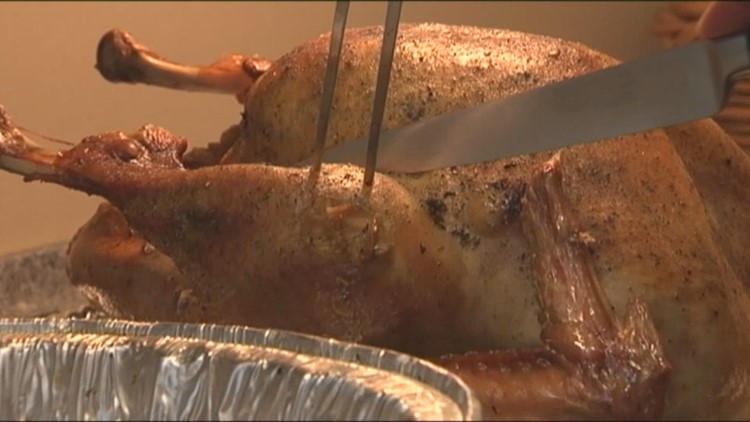SAN DIEGO — Turkey, mashed potatoes, salad, cranberry sauce, listeria, salmonella, E. coli — wait, what?
That’s right, Thanksgiving — the Super Bowl of cooking for home chefs — is upon us.
And if you’re not already thinking about safe cooking, like “keeping cold foods cold and hot foods hot,” hygiene, and keeping meats and veggies separated, your feast could be crashed by bacteria that could make you, and your family and friends, sick.
For example, you know you need to leave yourself four days to safely thaw a 20-pound turkey, right? (that’s 24 hours for every five pounds of bird)
Well, just in case, here’s the County Department of Environmental Health’s annual safe Turkey-day quiz to help you prepare! We’ll start with an easy question, just to see if you’ve been paying attention.
What’s the best way to thaw your turkey?
A. Put it out on the counter, don’t let anyone touch it and wait till the outside is mushy-soft.
B. Run hot water over it until it gets mushy-soft.
C. A large turkey should be defrosted — in the refrigerator — for at least 24 hours for every five pounds it weighs.
D. Let it sit in a pot of water until it gets (wait for it) mushy-soft!
Answer: C, of course. We just went over this a couple of seconds ago. Using the refrigerator to thaw slowly and evenly is the best, safest way to defrost a turkey or any meat. That’s because temperatures below 40 degrees Fahrenheit will slow most bacteria’s ability to multiply. Bacteria can grow exponentially at room temperatures. Note: The United States Department of Agriculture says that you can also thaw turkeys in cold water. But — and this is important — the water must be cold, under 40 degrees, and should be changed every 30 minutes to keep it cold. The refrigerator’s easier! Here’s more information about thawing turkeys.
Why should you keep raw meats and meat products separated from fruits and vegetables when cutting them up or preparing them?
A. Let’s face it. Meats and fruits and vegetables just don’t like each other. Avoid the food fight.
B. You don’t have to separate them. Paleo caveman diets are all the rage.
C. Meat can make your veggies taste weird. Or veggies can make your meat taste weird. Either way, weird.
D. Because raw meats, meat products and blood can carry bacteria like E. coli and salmonella that can contaminate fruits and vegetables — and make people sick.
Answer: If you said, D, you are correct! Cross-contamination is one of the most common causes of food-borne illness, according to the USDA. That is, the transfer of harmful bacteria from one food, particularly raw meats, poultry and shellfish to other foods. When preparing food, you need to keep raw meats and their juices away from fruits and vegetables and all ready-to-eat foods. If you can, use separate cutting boards for meats and produce. If you can’t, wash cutting boards with hot, soapy water after using them on raw meats and before using them to cut fruits and vegetables!
How often should you wash your hands and cutting boards when preparing food?
A. You don’t have to wash your hands and cutting boards. A few germs will toughen up your immune system! It’s like Nietzsche and Kelly Clarkson said. “That which does not kill us makes us stronger!”
B. Before you start cooking.
C. After you pet the dog, the cat, the gerbil or pick up the kids.
D. If you sneeze, blow your nose or have to run to the restroom.
E. Everything except answer A, but mainly, “OFTEN.”
Answer: Definitely E. (Get out of the kitchen if you answered A) You should wash your hands and cutting boards before and after everything in B, C and D. Handwashing is a key part of safe cooking. Harmful bacteria, from E. coli to salmonella and staphylococcus aureus, as well as viruses, can be removed from people’s hands through proper handwashing. Here are a few other things you should wash your hands after doing: coughing, blowing your nose, using the restroom handling money, eating, drinking, smoking and handling or preparing raw food.
Should you rinse off fruits and vegetables?
A. Nah, they grew in nature. That’s good enough for me.
B. Not if they look clean.
C. The supermarket washes them, right?
D. You should rinse fruits and vegetables with cold water to remove lingering dirt that can carry bacteria.
Answer: Absolutely D. Rinsing with cold water cleans off dirt and other contaminants. But don’t wash them with detergents or soap, even dishwashing soap. You could end up eating residues from those cleaners if they’re absorbed by fruits and vegetables.
What is the Danger Zone? And what does it have to do with Thanksgiving dinner?
A. OK, this is our favorite quiz answer — we’ve used it for years! The Danger Zone is that song from the ‘80s movie “Top Gun.” You know, “R-i-i-i-de into the danger zooooone!” Has nothing to do with Thanksgiving.
B. It’s the range of temperatures between 40 degrees Fahrenheit and 140 degrees Fahrenheit — the temperatures where bacteria can grow like crazy in foods, doubling in number in as little as 20 minutes.
C. It’s the distance you have to carry all the Thanksgiving food from your kitchen to the table — without dropping everything and ruining the feast!
Answer: As much as we love Top Gun, the correct answer is B! The Danger Zone is the range of temperature between 40 degrees and 140 degrees Fahrenheit that allows bacteria to breed exponentially — not a good thing. If hot foods cool or cold foods heat up enough to enter that zone, your food can become a bacteria-fest. And you can end up getting sick. Keep hot foods safely heated with chafing dishes, preheated steam tables, warming trays, slow cookers and ovens. Place cold foods in containers on ice, or in the fridge. And refrigerate leftovers as soon as you can. Here’s more about the “Danger Zone.”
Is the “five-second rule” real? Can you eat something you’ve dropped on the floor if you pick it up in less than five seconds?
A. Yes. It’s real. Just pick it up quickly and blow on it. Nothing can contaminate your food in less than five seconds.
B. It’s not real. You really shouldn’t eat anything you’ve dropped on floor.
C. I’ve eaten stuff that’s been on the floor a lot longer than five seconds and nothing happened to me.
Answer: B. C’mon! It’s OK for the dog to eat food that’s fallen to the ground, but it’s not safe for people. Truth is, almost any contact is long enough for food to be contaminated by bacteria that can be found on the ground or in your house. According to research conducted this year by Rutgers University, bacteria can transfer from a surface to food in less than a second!
So there you have it. We hope you’re an expert. But if you’re still interested, you can get more information about food safety tips at FoodSafety.gov’s “Food Safety by Types of Food” webpage, or by calling the USDA’s Meat and Poultry hotline at 1-888-674-6854.
Bon appétit! And have a happy and safe holiday!



